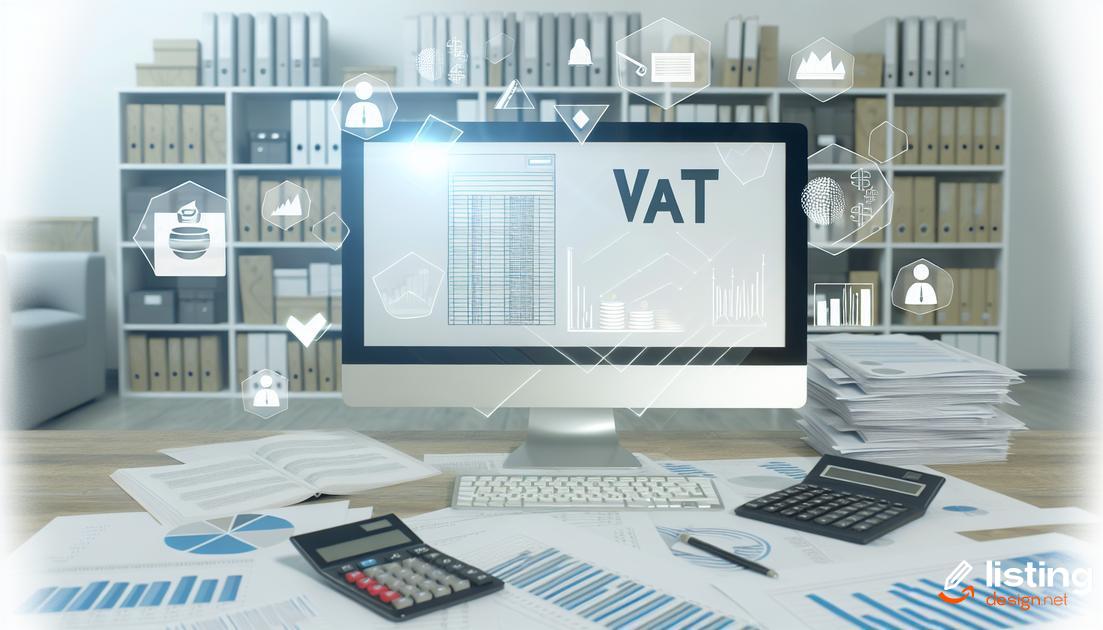VAT compliance for Amazon sellers is crucial to avoid legal issues and financial penalties. Understanding VAT obligations can be daunting, but it is essential for anyone selling on Amazon. In this article, we will explore various aspects of VAT compliance, including registering for VAT, calculating it accurately, and avoiding common mistakes. By following these guidelines, Amazon sellers can ensure they meet all their VAT obligations and stay on the right side of the law.
Table of Contents
Why VAT Compliance Matters for Amazon Sellers
VAT compliance is crucial for Amazon sellers for several reasons. First, non-compliance can lead to hefty fines and legal actions. Amazon, as a platform, requires sellers to adhere to VAT regulations in various regions. Failure to comply not only damages your reputation but may also result in account suspension.
Secondly, VAT compliance ensures you’re paying the correct amount of tax. This prevents overpayment or underpayment, both of which can create financial issues. Proper compliance also streamlines your financial operations, making it easier to manage your books and prepare for tax season.
Moreover, VAT compliance increases your business credibility. Customers, especially in the European market, are becoming increasingly savvy about VAT. Showing that you are VAT compliant can enhance customer trust and improve sales.
Lastly, being compliant with VAT regulations helps you avoid complications during audits. Tax authorities frequently conduct audits, and being prepared with accurate VAT records can make this process smoother and less daunting.
Understanding Basic VAT Obligations
What is VAT?
Value-Added Tax (VAT) is a consumption tax levied on goods and services in many countries around the world. As an Amazon seller, it is crucial to understand that VAT applies to the sale of products in various international markets.
Who Needs to Register for VAT?
Amazon sellers must register for VAT if their sales exceed the VAT threshold set by the country in which they are selling. This threshold can vary; for example, in the European Union, it is typically €10,000 from distance sales. Knowing and monitoring these thresholds is essential to avoid penalties.
VAT Registration Number (VRN)
Upon registering, you’ll receive a VAT Registration Number (VRN) that you must display on invoices and on your seller profile. Failure to provide a VRN can lead to complications in tax reporting and potential fines.
Charging VAT to Customers
Once registered, you are required to charge VAT on your sales. This means adding the VAT amount to the price of the product at the point of sale. Make sure you clearly inform customers about any additional VAT charges to maintain transparency.
Filing VAT Returns
You are obligated to file VAT returns periodically (monthly, quarterly, or annually, depending on the country). These returns detail the amount of VAT collected from customers and the VAT paid on business-related expenses. Ensure timely filing to avoid penalties.
Compliance is Key
Adhering to VAT obligations is non-negotiable for Amazon sellers aiming to succeed in international markets. Stay informed about specific VAT rules in each country where you operate and consult tax professionals if necessary.
Registering for VAT as an Amazon Seller
VAT registration is a critical step for any Amazon seller operating within the EU or selling to EU customers. Understanding the requirements can save you from potential fines and streamline your business operations.
To register for VAT, first determine which countries mandate VAT registration based on your sales volume and business model. Each EU country has specific thresholds for mandatory VAT registration. If your sales exceed these thresholds, you must register for VAT.
The registration process involves providing detailed business information, such as your company’s name, address, and tax identifiers. You may need to submit additional documentation depending on the specific requirements of the country where you’re registering.
Ensure that you maintain comprehensive records of all transactions and input VAT from the start. Proper record-keeping simplifies the VAT return process and ensures compliance with local tax authorities.
Consider seeking professional help from tax advisors or VAT compliance services, especially if you’re selling in multiple EU countries. They can navigate the complexities of VAT registration and help you avoid common pitfalls.
Calculating VAT on Your Amazon Sales
To calculate VAT on your Amazon sales, the first step is to determine if you’re selling within a country that requires VAT collection. Once verified, understand the applicable VAT rate; this can vary between standard, reduced, and zero rates depending on the product type. To compute the VAT, multiply your sales price by the VAT rate. For instance, if the rate is 20% and the sales price is $100, the VAT would be $20.
Next, ensure to include this VAT amount in the final price paid by the customer, so your listing displays the inclusive price. Keeping track of all taxable sales and VAT collected is crucial for accurate reporting. Utilize the tax calculation services provided by Amazon to automate this process, which can help in minimizing errors and saving time.
Lastly, regularly update your VAT rates and understand any changes in tax regulations. VAT obligations can change based on your sales volume and geographic expansion—selling in multiple EU countries may require you to register for VAT in each country.
Avoiding Common VAT Mistakes
Making errors in VAT compliance can lead to significant financial penalties and administrative burdens. One of the most common mistakes is failing to register for VAT on time. Ensure that you monitor your sales closely and understand the threshold for registration in each country where you operate.
Another frequent slip-up is misclassifying products. Different goods can have varying VAT rates, so it’s crucial to apply the correct rate. Incorrectly charged VAT can lead to overpayment or underpayment, both of which can trigger audits and penalties.
Pay close attention to invoicing. Invoices must be accurate and comply with local regulations. Incorrect or incomplete invoices can result in delays or fines. Make sure they include all mandatory information like VAT number, rate used, and total amount paid.
Record-keeping is key. Many Amazon sellers overlook maintaining accurate records. You need to keep detailed accounts of all transactions for VAT purposes. These records should be easily accessible in case of an audit.
Finally, beware of cross-border VAT complexities. VAT rules can differ significantly between countries. Gaining a thorough understanding of international VAT laws where you sell can prevent costly errors.
By paying attention to these common VAT pitfalls, you can streamline your VAT compliance and avoid unnecessary complications.
How to Automate Your VAT Compliance
Implementing automation in your VAT compliance process can save time and reduce errors. Amazon sellers often struggle with the complexity of VAT calculations and filing, but automation can streamline these tasks efficiently.
1. Use Specialized Software
Several software solutions are designed to handle VAT compliance automatically. These tools can integrate with your Amazon seller account, track your sales, and calculate VAT accurately according to the specific rates of different countries. This removes the manual effort and reduces the risk of errors.
2. Automated VAT Filing
Automation tools can also handle the filing of VAT returns. They can generate the necessary reports and submit them to tax authorities on your behalf. This ensures timely submissions and helps to avoid penalties for late filing or inaccurate data.
3. Real-time Compliance Monitoring
By automating your VAT processes, you can receive real-time updates on your compliance status. This includes notifications of any discrepancies or potential issues before they become significant problems. Staying updated helps in maintaining continuous compliance without last-minute rushes.
4. Data Accuracy and Consistency
Automation reduces the chances of human error in data entry and calculations. It ensures that all your transaction data is accurately recorded and compliant with the respective VAT regulations. This consistency is essential for maintaining trustworthy records and can be crucial during audits.
Ultimately, leveraging automation allows Amazon sellers to focus more on growing their business rather than getting bogged down by administrative tasks. Effective automation means streamlined processes, reduced workloads, and peace of mind knowing that your VAT compliance is managed smoothly.
Keeping Accurate VAT Records
Maintaining accurate VAT records is crucial for ensuring compliance with tax regulations and avoiding potential audits and penalties. For Amazon sellers, it’s essential to keep detailed records of sales, expenses, and VAT paid to streamline the reporting process.
Sales Record Keeping: Record every sale, including the date, amount, and VAT charged. Use spreadsheets or specialized software to track and categorize each transaction.
Expense Documentation: Keep copies of all expense receipts. Note the purpose of the purchase and the amount of VAT paid. Digital copies are acceptable, but ensure they are clear and legible.
Regular Updates: Regularly update your records to avoid last-minute scrambles. Set aside time weekly or monthly for this task, depending on your sales volume.
Using Software: Consider using VAT accounting software that can automatically generate reports, calculate totals, and provide insights into your VAT obligations. This can save time and reduce errors.
Audit Preparation: In case of an audit, having well-organized and up-to-date records will facilitate a smoother process. Ensure that your records are easily accessible and backed up securely.
Legal Compliance: Comply with local tax authority requirements for record retention. In many countries, businesses are required to keep VAT records for a minimum number of years.
Tools and Resources for VAT Compliance
VAT compliance tools are essential for Amazon sellers looking to streamline their tax processes. These tools help automate many aspects of VAT management, ensuring accuracy and saving time.
Popular Software Solutions:
Several software options cater to VAT compliance, such as Avalara, TaxJar, and Vertex. These platforms offer comprehensive features including automated tax calculation, filing, and reporting. Free Resources: Government websites and tax authority portals often provide free resources and guidelines for understanding VAT regulations. Additionally, online forums and communities can be valuable for sharing tips and experiences.
Expert Consultation:
Hiring a VAT consultant or outsourcing to a specialized firm can provide tailored advice and support, reducing the risk of errors and penalties. Training Programs: Participating in webinars, workshops, and online courses can enhance your knowledge of VAT compliance, helping you stay updated with the latest regulations and best practices. Utilizing these tools and resources effectively can simplify VAT compliance, allowing you to focus more on growing your Amazon business.






